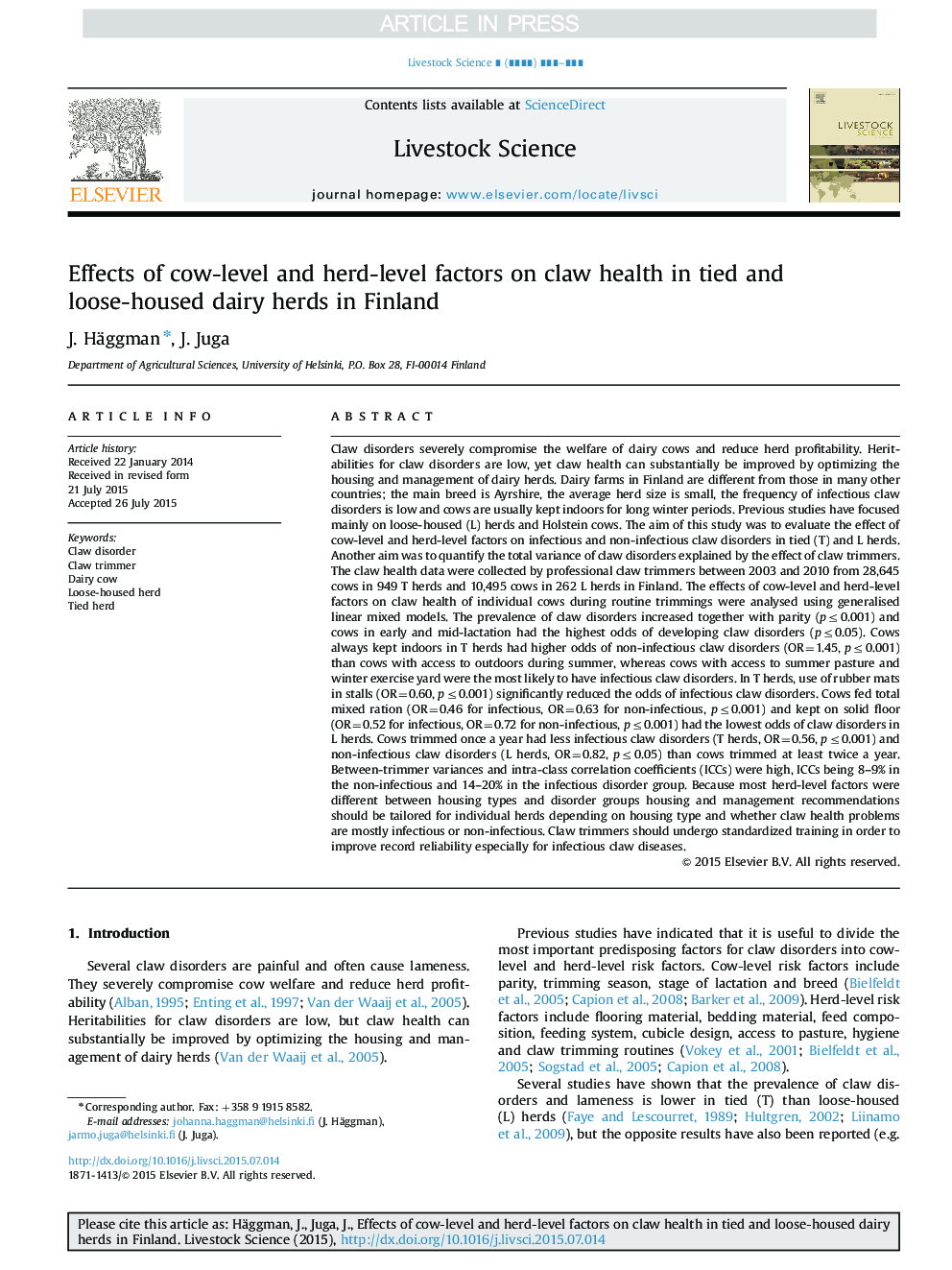| کد مقاله | کد نشریه | سال انتشار | مقاله انگلیسی | نسخه تمام متن |
|---|---|---|---|---|
| 8502160 | 1553951 | 2015 | 10 صفحه PDF | دانلود رایگان |
عنوان انگلیسی مقاله ISI
Effects of cow-level and herd-level factors on claw health in tied and loose-housed dairy herds in Finland
ترجمه فارسی عنوان
تأثیر عوامل گاو و سطح گله بر سلامت پنجه در گله های شیری گره خورده و چسبیده در فنلاند
دانلود مقاله + سفارش ترجمه
دانلود مقاله ISI انگلیسی
رایگان برای ایرانیان
کلمات کلیدی
اختلال پاره شدن سینه بند گاو شیری، گله ای که در آن قرار دارد گله گره خورده،
موضوعات مرتبط
علوم زیستی و بیوفناوری
علوم کشاورزی و بیولوژیک
علوم دامی و جانورشناسی
چکیده انگلیسی
Claw disorders severely compromise the welfare of dairy cows and reduce herd profitability. Heritabilities for claw disorders are low, yet claw health can substantially be improved by optimizing the housing and management of dairy herds. Dairy farms in Finland are different from those in many other countries; the main breed is Ayrshire, the average herd size is small, the frequency of infectious claw disorders is low and cows are usually kept indoors for long winter periods. Previous studies have focused mainly on loose-housed (L) herds and Holstein cows. The aim of this study was to evaluate the effect of cow-level and herd-level factors on infectious and non-infectious claw disorders in tied (T) and L herds. Another aim was to quantify the total variance of claw disorders explained by the effect of claw trimmers. The claw health data were collected by professional claw trimmers between 2003 and 2010 from 28,645 cows in 949 T herds and 10,495 cows in 262 L herds in Finland. The effects of cow-level and herd-level factors on claw health of individual cows during routine trimmings were analysed using generalised linear mixed models. The prevalence of claw disorders increased together with parity (pâ¤0.001) and cows in early and mid-lactation had the highest odds of developing claw disorders (pâ¤0.05). Cows always kept indoors in T herds had higher odds of non-infectious claw disorders (OR=1.45, pâ¤0.001) than cows with access to outdoors during summer, whereas cows with access to summer pasture and winter exercise yard were the most likely to have infectious claw disorders. In T herds, use of rubber mats in stalls (OR=0.60, pâ¤0.001) significantly reduced the odds of infectious claw disorders. Cows fed total mixed ration (OR=0.46 for infectious, OR=0.63 for non-infectious, pâ¤0.001) and kept on solid floor (OR=0.52 for infectious, OR=0.72 for non-infectious, pâ¤0.001) had the lowest odds of claw disorders in L herds. Cows trimmed once a year had less infectious claw disorders (T herds, OR=0.56, pâ¤0.001) and non-infectious claw disorders (L herds, OR=0.82, pâ¤0.05) than cows trimmed at least twice a year. Between-trimmer variances and intra-class correlation coefficients (ICCs) were high, ICCs being 8-9% in the non-infectious and 14-20% in the infectious disorder group. Because most herd-level factors were different between housing types and disorder groups housing and management recommendations should be tailored for individual herds depending on housing type and whether claw health problems are mostly infectious or non-infectious. Claw trimmers should undergo standardized training in order to improve record reliability especially for infectious claw diseases.
ناشر
Database: Elsevier - ScienceDirect (ساینس دایرکت)
Journal: Livestock Science - Volume 181, November 2015, Pages 200-209
Journal: Livestock Science - Volume 181, November 2015, Pages 200-209
نویسندگان
J. Häggman, J. Juga,
